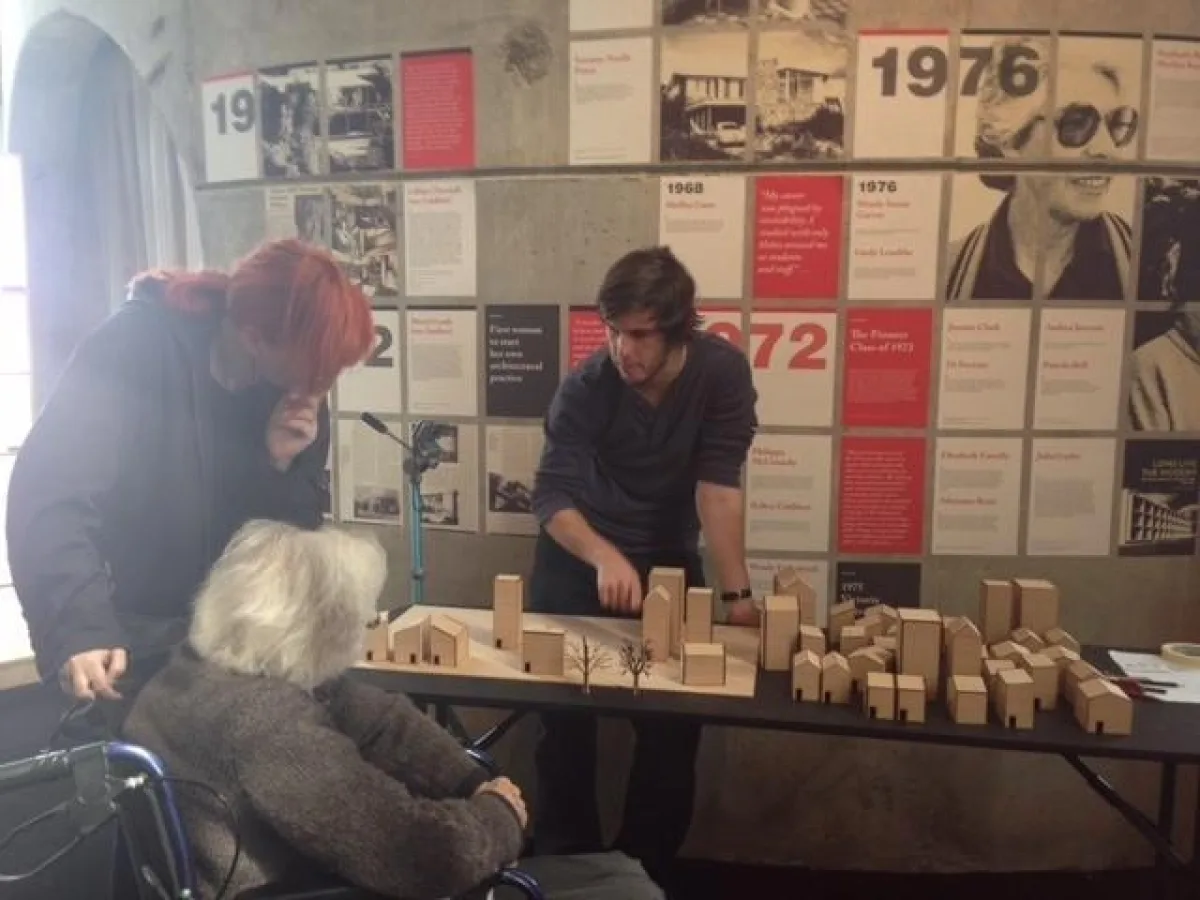Marilyn Reynolds
09 Feb 2015Obituary - Marilyn Reynolds
Architecture+Women•NZ are very sad to hear of the passing of Marilyn Reynolds (nee Hart) on Monday 31 August 2015. Marilyn was an original member of The Group, an architectural writer, the partner and mother in one of New Zealand's 'dynasty' architectural families and a valued member of Auckland's architectural community.
Marilyn visited the Between Silos exhibition in Auckland in 2013, where she featured in the Timeline display and copies of her books were available to read. For A+W•NZ, it was truly a highlight of the exhibition event to talk with her about her huge contribution to New Zealand's architectural history and legacy, as a writer, student, wife and mother.
Thank you to Deborah Smith for sharing the images of this special day.
The funeral service was held held on Tuesday 8 September, at 2pm in the Maclaurin Chapel, 18 Princes Street, Auckland. Our condolences go to the family and friends of Marilyn. A huge loss to our architecture community, she will be missed. (See below for the tribute given by Julia Gatley at the service.)

At Marilyn Reynolds’ funeral on 8 September 2015, Julia Gatley gave the following tribute.
Marilyn Lois Reynolds (nee Hart) (29 August 1927-31 August 2015)
On behalf the University of Auckland’s School of Architecture and Planning, I would like to acknowledge the importance of Marilyn’s life and career for women in New Zealand architecture.
Marilyn is among the earliest of the women who have worked in New Zealand architecture to have earned a place in our survey texts on the subject. For example, Peter Shaw, in New Zealand Architecture: From Polynesian Beginnings to 1990, published in 1991, mentions four women architects: Marilyn, and Barbara Parker, as two of the members of Auckland’s Architectural Group; Lillian Chrystal, for the award-winning Yock House in Remuera; and Briar Green, for Stanish & Green’s Evans House in Titirangi. Similarly, Douglas Lloyd Jenkins, in At Home: A Century of New Zealand Design (2004), mentions few women, but he too starts with Marilyn as a signatory to the Architectural Group’s constitution.
It can’t have been easy in the 1940s for a woman to decide to study architecture. But some people have a natural affinity for it, and drawing houses as a child and enjoying architecture magazines as a teenager show that Marilyn was one such person.
She knew she joined the School of Architecture as part of a great cohort. Their leader Bill Wilson was clearly a gifted speaker and story teller, a real raconteur, and the other members of that class, who became the Architectural Group, were obviously inspired by him and his desire to talk, to write, to publish, to have a voice. As I say, Marilyn recognised that it was a great cohort, commenting to Gill Matthewson in 2008 that:
I was just there at the time and it [the Group ideology] appealed to me. All the things I was interested in, they were interested in. The fact that I never ever became an architect or I was never a fully-fledged Group member, for long anyway, is neither here nor there. But I was just lucky enough to be there at the time with that particular group of people. (Group Architects, 2010, p. 15)
And what the Architectural Group wrote in 1946 was also important. We are still quoting them: ‘overseas solutions will not do. New Zealand must have its own architecture, its own sense of what is beautiful and appropriate to our climate and conditions.’
Marilyn fell for her tutor, Ian Reynolds, and went to the UK where they married him and she worked first in London and then for the City Architect in Coventry, contributing to the post-war re-build.
On their return to New Zealand and to life in Auckland, children absorbed much of her time, but with an architect-husband, she was never far removed from thinking and talking about architecture and design. Then from the 1970s, once the children were older, with Stephanie Bonny she wrote an impressive collection of books and pamphlets:
- Woman’s World: Houses and Suburbs, 1976;
- Living with 50 Architects: A New Zealand Perspective, 1980, the best known of the books;
- Housing Choices for the Elderly, 1981;
- Practical Planning for Retirement, 1984;
- New Zealand Houses Today, 1988; and
- Looking Ahead: Housing Choices for Retirement, 1991.
The books are a huge achievement. Their themes also demonstrate the alignment of Marilyn’s thinking with that of others from the Architectural Group, including an interest in low-cost housing, and not only a belief in, but also a desire to promote, the idea that different kinds of people need different kinds of housing.
It is for all of this, that I recognise the importance of Marilyn’s life and work for women in New Zealand architecture. She earned a place in the historical record and future generations will continue to know her name and her achievements.












